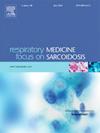临床实践中治疗慢性阻塞性肺疾病肺特征的精准医疗策略:N-乙酰半胱氨酸的作用。
IF 3.5
3区 医学
Q2 CARDIAC & CARDIOVASCULAR SYSTEMS
引用次数: 0
摘要
慢性阻塞性肺病(COPD)是一种渐进性肺部疾病,也是导致体力衰退和死亡的主要原因。预计未来几年慢性阻塞性肺病的发病率将稳步上升,因此,这种疾病带来的医疗保健和社会负担也将加重。在这种情况下,一种以患者为中心的方法--可治疗特质(TT)策略应运而生,该策略的基础是确定与临床相关、可识别、可监测和可治疗的特质。TT 策略考虑了行为/风险因素以及肺部和肺外特征,已被证明是慢性阻塞性肺病管理中一种很有前景的策略。本研究回顾了慢性阻塞性肺病的 TT 策略,特别关注最相关的肺部特征,如频繁有痰咳嗽、慢性支气管炎、2 型炎症、中性粒细胞炎症、肺过度充气、支气管扩张、病情加重和非可逆气流受限。N- 乙酰半胱氨酸(NAC)是一种广泛使用的粘液溶解剂,可能是这一策略的主要角色。事实上,通过对文献的深入研究,我们可以发现,NAC 除了是治疗频繁有痰咳嗽的重要药物外,还能为气流受限、气道炎症、病情加重和支气管扩张带来益处。此外,还介绍了一个临床病例,在该病例中,TT 策略能够减轻症状,改善肺功能和生活质量,最大限度地减少不必要的药物治疗和副作用。通过个性化医疗识别 TT 并对其进行适当治疗,可显著改善慢性阻塞性肺病的治疗效果。值得注意的是,NAC 的粘液溶解、抗氧化和抗炎活性可能对多种 TTs 有益。本文章由计算机程序翻译,如有差异,请以英文原文为准。
The precision medicine strategy to treat COPD pulmonary traits in clinical practice: The role of N-acetylcysteine
Chronic obstructive pulmonary disease (COPD) is a progressive lung condition and a leading cause of physical decline and death. COPD prevalence is expected to increase steadily in the coming years, and as a result, the healthcare and social burden of this condition will intensify. In this scenario, a patient-centric approach, the treatable trait (TT) strategy, based on the identification of traits that are clinically relevant, identifiable, monitorable and treatable, has emerged. The TT strategy, which considers behavioral/risk factors, as well as pulmonary and extrapulmonary traits, has shown to be a promising strategy in COPD management. This work reviews the TT strategy in COPD, giving special attention to the most relevant pulmonary traits, such as frequent productive cough, chronic bronchitis, type 2 inflammation, neutrophilic inflammation, lung hyperinflation, bronchiectasis, exacerbations and non‐reversible airflow limitation. N-acetylcysteine (NAC), a widely used mucolytic agent, might be a major player in this strategy. Indeed, through a thorough review of the literature, it has been possible to highlight that, besides being essential in the treatment of frequent productive cough, NAC could bring benefits in case of airflow limitations, airways inflammation, exacerbations and bronchiectasis.
A clinical case in which the TT strategy was able to reduce symptoms and improve lung function and quality of life, minimizing unnecessary medication and side effects, is also presented. The identification of TTs and their proper treatment through personalized medicine remarkably ameliorates COPD management. Of note, the mucolytic, antioxidant, and anti-inflammatory activities of NAC might have beneficial effects on several TTs.
求助全文
通过发布文献求助,成功后即可免费获取论文全文。
去求助
来源期刊

Respiratory medicine
医学-呼吸系统
CiteScore
7.50
自引率
0.00%
发文量
199
审稿时长
38 days
期刊介绍:
Respiratory Medicine is an internationally-renowned journal devoted to the rapid publication of clinically-relevant respiratory medicine research. It combines cutting-edge original research with state-of-the-art reviews dealing with all aspects of respiratory diseases and therapeutic interventions. Topics include adult and paediatric medicine, epidemiology, immunology and cell biology, physiology, occupational disorders, and the role of allergens and pollutants.
Respiratory Medicine is increasingly the journal of choice for publication of phased trial work, commenting on effectiveness, dosage and methods of action.
 求助内容:
求助内容: 应助结果提醒方式:
应助结果提醒方式:


